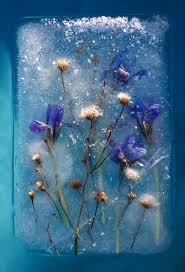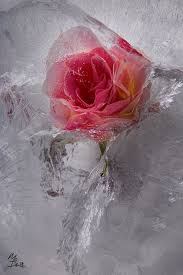When we think of flowers, we often imagine their vibrant colors, captivating fragrances, and fleeting lifespan. However, freezing flowers offers a way to capture these ephemeral wonders in a stunning and enduring form.
Preserving flowers through freezing is a popular technique used by floral enthusiasts, artists, and even scientists. By subjecting the flowers to extremely low temperatures, typically in a freezer, their natural grace and charm are retained, allowing them to be admired for an extended period.
One of the primary uses of frozen flowers lies in creating captivating floral arrangements. Whether it’s for a special event like a wedding or a simple decoration for the home, these preserved blossoms can add a touch of elegance and uniqueness. Unlike fresh flowers, which may wither within days, frozen flowers can maintain their exquisite appearance for an extended duration, allowing for long-lasting displays that brighten any environment.
Beyond their decorative applications, frozen flowers also hold sentimental value for many. Couples often choose to freeze flowers from their wedding bouquets, preserving the memories of their special day for years to come. These frozen keepsakes carry the emotions and joy of the occasion, symbolizing the enduring nature of love and happiness.
Artists find inspiration in frozen flowers, using them as mediums for their creativity. By embedding these icy blossoms into sculptures or crafting delicate ice-themed installations, they can evoke feelings of wonder and appreciation for the transient beauty found in nature. The juxtaposition of delicate petals encased in frozen stillness sparks curiosity and awe, making frozen flowers a captivating subject for artistic exploration.
Scientific researchers also harness the power of freezing flowers for their studies. By preserving flowers at specific stages of their life cycle, scientists can examine their physical properties and analyze changes over time. This preservation method aids in understanding the intricate biology of flowers and contributes to various fields, such as botany and horticulture.
Freezing flowers is a relatively simple process. When the flowers are at their peak freshness, they are carefully harvested and placed in a suitable container, like an airtight bag. Then, they are stored in a freezer at low temperatures. This freezing process locks in the flowers’ original colors, shapes, and textures, ensuring their natural beauty remains intact.
While the freezing technique magnificently preserves the appearance of flowers, it is important to note that it does not retain their scents. The icy temperatures can diminish or eliminate the natural fragrance that fresh flowers carry.
However, frozen flowers offer a captivating way to preserve the allure of nature’s floral wonders. From adorning decorations and commemorating special moments to inspiring artistry and aiding scientific research, these delicate frozen treasures encapsulate the essence of fleeting beauty and its enduring impact on our lives. So, the next time you encounter a frozen flower, take a moment to appreciate the artistry of preservation and the everlasting charm of nature’s creations in ice.
Read Also: All You Need To Know About Animal Shelters
Uses of Frozen Flowers

Frozen flowers have various uses and applications, each highlighting the beauty and versatility of preserving nature’s floral wonders in ice. Here are some of the key uses of frozen flowers:
1. Floral Decorations: Frozen flowers are commonly used in floral arrangements for decorative purposes. Whether it’s for weddings, parties, or other events, these preserved blossoms add an elegant and unique touch to the décor. Unlike fresh flowers that may wither quickly, frozen flowers maintain their beauty for an extended period, allowing for long-lasting and visually appealing displays.
2. Keepsakes: Many people choose to freeze flowers as keepsakes to preserve memories of special occasions. For instance, frozen flowers from wedding bouquets or anniversary bouquets serve as enduring reminders of cherished moments. These frozen keepsakes carry sentimental value and symbolize lasting love and happiness.
3. Artistic Creations: Artists find inspiration in frozen flowers and use them as artistic mediums. Embedding these icy blossoms into sculptures or crafting ice-themed installations creates captivating artworks that evoke wonder and appreciation for the transient beauty of nature. The combination of delicate petals encased in frozen stillness sparks curiosity and serves as a captivating subject for artistic exploration.
4. Scientific Research: Frozen flowers are valuable in scientific research, particularly in fields like botany and horticulture. Researchers can preserve flowers at specific stages of their life cycle to study their physical properties and analyze changes over time. This preservation method aids in understanding the biology and characteristics of flowers, contributing to advancements in botanical knowledge.
5. Educational Purposes: Frozen flowers can be used for educational purposes in schools, botanical gardens, and nature centers. They offer an engaging and hands-on way to teach students about the anatomy, structure, and diversity of flowers. Through the examination of frozen flowers, learners can better understand the intricacies of plant life.
6. Symbolic Gifts: Giving frozen flowers as gifts carries a unique symbolism. It represents the enduring nature of the sentiment behind the gesture, as the frozen flowers serve as a lasting reminder of the giver’s affection or appreciation.
7. Culinary Applications: In some culinary creations, frozen flowers can be used as attractive and edible decorations. For instance, they may be used to adorn cakes, desserts, or cocktails, adding a touch of natural beauty to the presentation.
8. Environmental Art Installations: Frozen flowers can be employed in temporary environmental art installations. By placing them in natural settings, such as frozen lakes or snowy landscapes, artists can create visually striking and thought-provoking installations that explore the relationship between nature, time, and human intervention.
Overall, frozen flowers showcase the art of preserving nature’s fleeting beauty. Their uses extend beyond mere decoration, encompassing sentimental value, artistic expression, scientific exploration, and educational enrichment, all while paying homage to the ephemeral grace of flowers
Read Also: Options for Genetic Improvement in Tropical Livestock
Method of Freezing Flowers

Methods of freezing flowers involve careful preparation and storage to ensure the preservation of their natural beauty. Here are the main steps and techniques used to freeze flowers successfully:
1. Harvesting at the Right Time: Choose flowers at their peak freshness and beauty for freezing. Avoid flowers that are already wilting or showing signs of decay, as these may not freeze well.
2. Watering and Conditioning: Before freezing, ensure the flowers are well-hydrated by placing them in water for a few hours. Conditioning the flowers helps them absorb water and maintain their freshness during the freezing process.
3. Remove Excess Moisture: Gently shake the flowers to remove any excess water or droplets on the petals. Excess moisture can lead to freezer burn and affect the appearance of the frozen flowers.
4. Choose Suitable Flowers: Not all flowers are ideal for freezing. Roses, carnations, lilies, and certain other hardy varieties tend to freeze well. Delicate flowers like orchids may not preserve their appearance as effectively.
5. Select the Right Freezing Containers: Use airtight containers, plastic bags, or vacuum-sealed packages to store the flowers. These containers help prevent moisture and air from affecting the flowers during freezing.
6. Single or Bundled Flowers: Decide whether to freeze individual flowers or bundle them together. Individual flowers offer more flexibility in arrangements, while bundling can be convenient for specific display purposes.
7. Flower Positioning: Arrange the flowers carefully in the containers, ensuring they are spaced apart to prevent sticking together during freezing.
8. Pre-Freezing: Some florists recommend placing the prepared flowers in the freezer for a few hours before the final freezing step. This step helps the flowers adjust to the low temperatures gradually.
9. Final Freezing: Once the flowers have been pre-frozen, transfer them to the chosen airtight containers and seal them tightly. Place the containers in the freezer at a temperature below freezing (usually around 0°F or -18°C).
10. Storage Time: Frozen flowers can be stored for several months, but it is advisable to use them within 6-8 months for best results. Over time, the quality and appearance of the flowers may deteriorate.
11. Thawing: When ready to use the frozen flowers, remove them from the freezer and allow them to thaw at room temperature. Avoid direct sunlight or heat sources during thawing, as rapid changes in temperature may damage the flowers.
12. Protective Measures: If the flowers will be displayed in an arrangement, consider using floral foam or other support materials to hold them in place.
It’s important to note that while freezing preserves the appearance of flowers, it does not retain their natural fragrance. Additionally, some flowers may experience minor color changes during the freezing process, but overall, freezing provides an effective method to enjoy the beauty of flowers long after their natural bloom time has passed.
Read Also: Revolutionizing Wastewater Treatment
